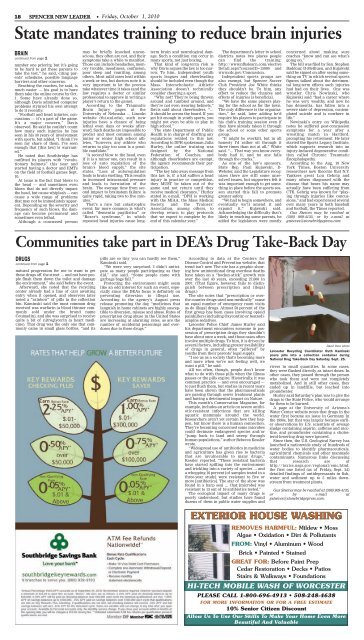october specials - Southbridge Evening News
october specials - Southbridge Evening News
october specials - Southbridge Evening News
Create successful ePaper yourself
Turn your PDF publications into a flip-book with our unique Google optimized e-Paper software.
18 SPENCER NEW LEADER • Friday, October 1, 2010<br />
State mandates training to reduce brain injuries<br />
BRAIN<br />
continued from page 1<br />
number one priority, but it’s going<br />
to be hard to get these parents to<br />
take the test,” he said, citing parents’<br />
schedules, possible language<br />
barriers and other concerns.<br />
Reaching the coaches, he said, is<br />
much easier — his goal is to have<br />
them take the online course by Oct.<br />
1. Some have already done so,<br />
although Davis admitted computer<br />
problems stymied his own attempt<br />
to do it recently.<br />
“Football and head injuries, concussions<br />
— it’s a part of the game.<br />
It’s a major concern,” Davis<br />
observed. He said he couldn’t count<br />
how many such injuries he has<br />
seen in his 30 years of involvement<br />
with sports, but added, “I think I’ve<br />
seen my share of them. I’ve seen<br />
enough that [this law] is warranted.”<br />
He noted that <strong>Southbridge</strong> has<br />
outfitted its players with “revolutionary<br />
helmets” this year and<br />
started having a doctor and EMTs<br />
on the field at football games Sept.<br />
10.<br />
At issue is the fact that blows to<br />
the head — and sometimes even<br />
blows that do not directly impact<br />
the head, but cause whiplash — can<br />
cause a wide range of problems<br />
that may not be immediately apparent.<br />
Depending on the severity and<br />
frequency of such blows, the damage<br />
can become permanent and<br />
sometimes even lethal.<br />
Although a concussed person<br />
may be briefly knocked unconscious,<br />
they often are not, and their<br />
symptoms take a while to manifest.<br />
Those can include headaches, memory<br />
trouble, moodiness, confusion,<br />
poor sleep and vomiting, among<br />
others. Most mild cases heal within<br />
a week or two, but doctors note it is<br />
very important to let the process<br />
take whatever time it takes (and the<br />
law requires a doctor or similar<br />
professional to approve in writing a<br />
player’s return to the game).<br />
According to the Traumatic<br />
Brain Injury pages at the<br />
University of Nebraska — Lincoln<br />
website (tbi.unl.edu), such new<br />
injuries have a chance of being<br />
lethal even days or weeks afterward.<br />
Such deaths are impossible to<br />
predict and most common among<br />
junior or senior high school athletes,<br />
“however, any athlete who<br />
returns to play too soon is a possible<br />
candidate.”<br />
“A second blow to the head, even<br />
if it is a minor one, can result in a<br />
loss of auto regulation of the<br />
brain’s blood supply,” the site<br />
states. “Loss of autoregulation<br />
leads to brain swelling. This results<br />
in increased intracranial pressure<br />
and leads to herniation of the<br />
brain. The average time from second<br />
impact to brainstem failure is<br />
quite rapid, taking two to five minutes.”<br />
That’s a rare but catastrophic<br />
event; far more common is what’s<br />
called “dementia pugilistica” or<br />
“Boxer’s syndrome,” in which<br />
repeated head injuries cause longterm<br />
brain and neurological damage.<br />
Such a condition can occur in<br />
many sports, not just boxing.<br />
That kind of long-term risk is<br />
why Davis argues the law is too narrow.<br />
To him, independent youth<br />
sports leagues and cheerleading<br />
should be included even though the<br />
Mass. Interscholastic Athletic<br />
Association doesn’t technically<br />
consider cheering a sport.<br />
“Why not? They’re being thrown<br />
around and tumbled around, and<br />
they’re not even wearing helmets,”<br />
Davis said about cheerleaders. “…<br />
It should be across the board. If you<br />
get hit enough in youth sports, you<br />
might not even be able to play in<br />
high school.”<br />
The state Department of Public<br />
Health is in charge of drafting any<br />
regulations related to this law.<br />
According to DPH spokesman Julia<br />
Hurley, the online training was<br />
designed by the National<br />
Federation of Coaches, and<br />
although cheerleaders are exempt,<br />
the agency recommends their participation.<br />
“The key take away message from<br />
this law is, if a kid suffers a head<br />
injury in practice or competition,<br />
they MUST be taken out of the<br />
game and not return until they<br />
receive medical clearance,” Hurley<br />
stated in e-mail. “DPH is working<br />
with the MIAA, the Mass Medical<br />
Society, and the Trainers’<br />
Association, among others, to<br />
develop return to play protocols<br />
that we expect to complete by the<br />
end of this calendar year.”<br />
The department’s letter to school<br />
districts notes two places people<br />
can find the training:<br />
http://www.nfhslearn.com/elective<br />
Detail.aspx?courseID=15000 and<br />
www.cdc.gov/Concussion.<br />
Independent sports groups are<br />
also exempt, but Spencer Soccer<br />
Club President Joe White thinks<br />
they shouldn’t be. To him, any<br />
effort to reduce the chances and<br />
effects of injuries is beneficial.<br />
“We have the same players playing<br />
for the school as for the town.<br />
The only difference is the organization,”<br />
he said, later adding he’d<br />
require his players to participate in<br />
his club’s training session even if<br />
they have already taken it through<br />
the school or some other sports<br />
group.<br />
“It might be overkill, but in all<br />
honesty I’d rather sit through it<br />
three times than not at all,” White<br />
said. “… That way you know everybody<br />
had it, and no one falls<br />
through the cracks.”<br />
As one of the law’s sponsors,<br />
State Rep. Paul Kujawski, D-<br />
Webster, said the Legislature recognizes<br />
there are still some unresolved<br />
issues, but supporters felt it<br />
was important enough to get something<br />
in place before the sports season<br />
started this fall to promote<br />
greater safety.<br />
“We had to begin somewhere, and<br />
eventually we’ll amend it and<br />
expand it,” Kujawski said.<br />
Acknowledging the difficulty that’s<br />
likely in reaching some parents, he<br />
added the legislators were mostly<br />
concerned about making sure<br />
coaches “know and can see what’s<br />
going on.”<br />
The bill was filed by Sen. Stephen<br />
Baddour, D-Methuen, and Kujawski<br />
said he signed on after seeing something<br />
on TV in which several sports<br />
figures talked about the detrimental<br />
long-term effects such injuries<br />
had had on their lives. One was<br />
wrestler Chris Nowinski, who<br />
Kujawski said “had a career where<br />
he was very wealthy, and now he<br />
has dementia, has fallen into a<br />
severe state of depression, contemplated<br />
suicide and is nowhere in<br />
life.”<br />
Nowinski’s entry on Wikipedia<br />
notes he suffered post-concussion<br />
symptoms for a year after a<br />
wrestling match in Hartford,<br />
prompting his retirement. He later<br />
started the Sports Legacy Institute,<br />
which supports research into an<br />
injury-induced degenerative condition<br />
called Chronic Traumatic<br />
Encephalopathy.<br />
According to the Aug. 18 New<br />
York Times, Boston University<br />
researchers now theorize that N.Y.<br />
Yankees great Lou Gehrig and<br />
many others diagnosed with the<br />
disease that bears his name may<br />
actually have been suffering from<br />
CTE. Gehrig was known for “playing<br />
through injuries like concussions,”<br />
and had experienced several<br />
over many years in both baseball<br />
and football, the Times reported.<br />
Gus Steeves may be reached at<br />
(508) 909-4135, or by e-mail at<br />
gsteeves@stonebridgepress.com.<br />
Communities take part in DEA’s Drug Take-Back Day<br />
DRUGS<br />
continued from page 1<br />
natural progression for me to want to get<br />
these drugs off the street … and not have people<br />
flush them down the toilet and damage<br />
the environment,” she said before the event.<br />
Afterward, she noted that the recycling<br />
center already had a line of cars awaiting<br />
entry when it opened, and observers later<br />
noted a “rainbow” of pills in the collection<br />
bin. Kaminski said the most common drug<br />
received was warfarin (a blood thinner commonly<br />
sold under the brand name<br />
Coumadin), and she was surprised to receive<br />
quite a bit of nitroglycerin (a heart medicine).<br />
That drug was the only one that commonly<br />
came in small glass bottles, “and its<br />
pills are so tiny you can hardly see them,”<br />
Kaminski said.<br />
“We were very surprised. I didn’t anticipate<br />
as many people participating as they<br />
did,” she said. “Some people came with<br />
garbage bags full.”<br />
Protecting the environment might seem<br />
like an odd interest for such an event, especially<br />
since the DEA’s focus is definitely on<br />
preventing diversion to illegal use.<br />
According to the agency’s August press<br />
release promoting the day, “medicines that<br />
languish in home cabinets are highly susceptible<br />
to diversion, misuse and abuse. Rates of<br />
prescription drug abuse in the United States<br />
are increasing at alarming rates, as are the<br />
number of accidental poisonings and overdoses<br />
due to these drugs.”<br />
According to data at the Centers for<br />
Disease Control and Prevention website, that<br />
trend isn’t new. The site has a graphic showing<br />
how unintentional drug overdose deaths<br />
have taken on a “hockey-stick” growth rate<br />
over the last 40 years, exceeding 27,600 in<br />
2007. (That figure, however, fails to distinguish<br />
between prescription and illegal<br />
drugs.)<br />
The site notes that “prescription or overthe-counter<br />
drugs used non-medically” cause<br />
an equal number of emergency room visits<br />
as do illegal drugs. Almost 58 percent of the<br />
first group has been cases involving opioid<br />
painkillers (including Oxycontin) or benzodiazapine<br />
sedatives.<br />
Leicester Police Chief James Hurley said<br />
his department encounters someone in possession<br />
of prescription drugs they shouldn’t<br />
have about once a week, and those cases often<br />
involve multiple drugs. To him, it is driven by<br />
several factors, including greater availability<br />
of drugs in general, often “pilfered” by<br />
youths from their parents’ legal supply.<br />
“I see us as a society that’s becoming more<br />
and more when we’re not feeling well, we<br />
want a pill,” he said.<br />
All too often, though, people don’t know<br />
what to do with those pills when the illness<br />
passes or the pills expire. Historically, it was<br />
common practice — and even encouraged —<br />
to just flush them, but studies in recent years<br />
have been shown that the pharmaceuticals<br />
are passing through sewer treatment plants<br />
and having a detrimental impact on Nature.<br />
This month’s Conservation Magazine, for<br />
example, includes an article on severe antibiotic-resistant<br />
infections that are killing<br />
aquatic mammals around the world.<br />
Researchers aren’t yet certain how they happen,<br />
but know there is a human connection.<br />
They’re becoming concerned some microbes<br />
could decimate endangered species and/or<br />
“jump back to land and sweep through<br />
human populations,” author Rebecca Kessler<br />
wrote.<br />
“Widespread use of antibiotics in medicine<br />
and agriculture has given rise to bacteria<br />
that are invulnerable to many drugs,”<br />
Kessler reported. “These resistant bacteria<br />
have started spilling into the environment<br />
and trickling into a variety of species … and<br />
a whopping 16 percent [of samples tested in a<br />
three-year study] were resistant to five or<br />
more [antibiotics]. The star of the show was<br />
found in a harp seal … that [microbe] was<br />
resistant to 13 out of 16 antibiotics tested.”<br />
The ecological impact of many drugs is<br />
poorly understood, but studies have found<br />
dozens of them in public water supplies and<br />
David Dore photo<br />
Leicester Recycling Coordinator Ruth Kaminski<br />
pours pills into a collection container during<br />
National Drug Take-Back Day Saturday, Sept. 25.<br />
rivers in small quantities. In some cases,<br />
they were flushed directly, as intact doses. In<br />
other cases, they passed through the person<br />
who took them and were not completely<br />
metabolized. And in still other cases, they<br />
ended up in landfills, but leached into<br />
groundwater.<br />
Hurley said Saturday’s plan was to give the<br />
drugs to the State Police, who would arrange<br />
for them to be burned.<br />
A page at the University of Arizona’s<br />
Water Center website notes that drugs in the<br />
water first became an issue in Germany in<br />
the 1990s, but that was largely because earlier<br />
observations by U.S. scientists of sewage<br />
sludge containing aspirin, caffeine and nicotine,<br />
and groundwater containing a cholesterol-lowering<br />
drug were ignored.<br />
Since then, the U.S. Geological Survey has<br />
launched a nationwide study of hundreds of<br />
water bodies to identify pharmaceuticals,<br />
agricultural chemicals and other manmade<br />
contaminants. Numerous links discussing<br />
that research are at<br />
http://toxics.usgs.gov/regional/emc.html;<br />
the first one listed (as of Friday, Sept. 24)<br />
detailed findings of antidepressants in fish,<br />
water and sediment up to 5 miles downstream<br />
from treatment plants.<br />
Gus Steeves may be reached at (508) 909-4135,<br />
or by e-mail at<br />
gsteeves@stonebridgepress.com.<br />
EXTERIOR HOUSE WASHING<br />
REMOVES HARMFUL: Mildew • Moss<br />
Algae • Oxidation • Dirt & Pollutants<br />
FROM: Vinyl • Aluminum • Wood<br />
Brick • Painted • Stained<br />
GREAT FOR: Before Paint Prep<br />
Cedar Restoration • Decks • Patios<br />
Stairs & Walkways • Foundations<br />
HI-TECH MOBILE WASH OF WORCESTER<br />
PLEASE CALL 1-800-696-4913 • 508-248-4638<br />
FOR MORE INFORMATION OR FOR A FREE ESTIMATE<br />
10% Senior Citizen Discount<br />
Allow Us To Use Our Skills To Make Your Home Even More<br />
Beautiful And Valuable
















